

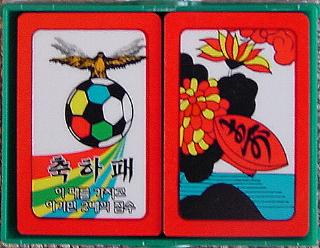
THE CARDS
Go-Stop (sometimes called Godori, for reasons you'll learn soon enough) is played with small thick cards called hwa-tu in Korea, and hanafuda in Japan. This type of card used to be the mainstay product of Japanese game company Nintendo, until videogames came along. Nintendo still makes cards, but there are also many other companies that make these cards today, especially in Korea.
The cards used to play Go-Stop are smaller and thicker than playing cards used in the West. Hwa-tu are approx. 1 & 3/8" wide by 2 & 1/8" high. (That's an average size I derived from two Korean decks I own - one is a little smaller, one is a little larger, than the measurements given here.)
Hwa-tu make a satisfying "snap" sound when thrown down with vigor. They're also a little tricky to shuffle. To shuffle hwa-tu cards, hold the deck in the left hand, face-down, cupped between the fingers and thumb (face of bottom card resting on palm). With the right hand, grab a random hunk of cards from the deck, pull them out, and stack them on top. Repeat several times. With enough practice, you can do it rapidly.
Hwa-Tu Deck Breakdown
Korean hwa-tu decks are comprised of:
The Suit Cards
There are 12 suits, each with four cards.
Each suit represents a flower or plant, and a month of the year. For example, the four "cherry blossom" ("sakura") cards represent the month of March.



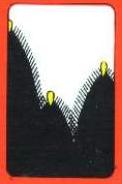


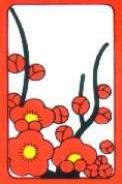


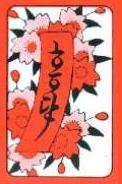
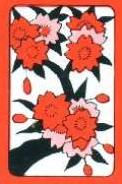




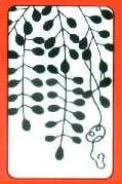



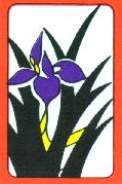


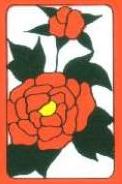



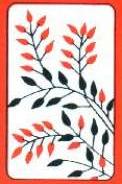














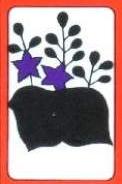






Brights, Animals, Ribbons, & Junk (pi)
Even a casual glance at the suit cards above reveals that the cards within a suit are far from identical. Distributed unevenly among the suit cards are depictions of animals, objects, Chinese characters, and ribbons of two colors.
















































These four different types of cards are distributed unevenly among the suits. Since there are only five Brights, there are seven suits that don't have any. There are suits without ribbon cards or animal cards, too. And notice that while most suits have two pi (junk cards), the November suit (Rain) has just one pi - and the December suit (Paulownia) has three.
The suit of November (Willow or Rain) is the only one that has one of each of the four card types. This uneven distribution greatly enhances the playability (and must be reflected in the strategy), of the hanafuda family of games.
The Extra Cards
As mentioned above, Korean hwa-tu decks come with extra cards not found in Japanese hanafuda decks. Korean decks usually come with five different joker cards, and a specially-marked Rain Junk card.





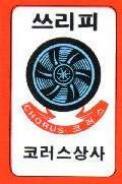
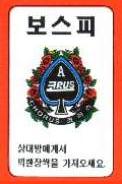
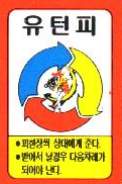
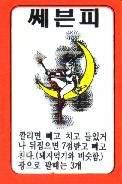
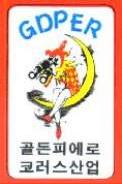

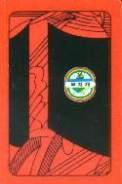
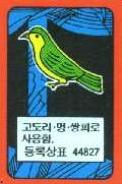
When using the Rain junk as a double-Junk ("sang-pi"), use the specially-marked Rain junk card, if your deck comes with one, instead of the unmarked Rain junk.
The Type 1 joker cards were explained to me in some detail by Taesun Yeom, but I haven't researched the uses of the Type 2 joker cards seen above.
Most players don't use all the joker cards the way they're intended (writing on the cards tells the player how to use them). Most players, and most arcade Go-Stop games, only use the two simplest types of jokers: jokers that give you one, two, or three extra pi (junk cards). You can use them all, if you want! See the three rules on table rules.)
We'll examine the use of the joker cards later.
Some new information about the Paulownia and Poetry Ribbon cards, from the Q&A Bulletin Board here on Sloperama...
>From: "Dan Lewis" [lewis_dan@hotmail.co m>
Hi Dan,
1. I think the reason for calling Paulownia "poop" is that it looks like shapeless blobs. Hawaiians have fun nicknames for the suits too - see the Japanese koi-koi section of my Hanafuda zone for that.
2. Heungdahn, Chungdahn. I appreciate your looking further into that. Will definitely add the info to the Go-Stop pages.
That's cool that you're living in Korea. What little I've seen of it is very nice (I've only been in Seoul, twice now). - Tom
>From: benny - bennywong♣kol.co.nz
Korean Go-Stop
>Subject: Hwa-Tu cards
>Date: Thu, 24 Mar 2005 22:03:46 -0700
>Hey man what's up. You definitely have the best page about Go-Stop in English. I have been living in Korea for well nigh 4 years now. I have learned a thing or two about go-stop.
>
>First of all, most Koreans have no idea what's on the cards. . . for example, most Koreans call the "Paulownia" card Ddong, which means basically [DELETED] or poop (its an affectionate thing, I think). I looked up the flower and it's considered a weed in most places, so that might be why. But I think they call it that because Koreans don't know what's on the card.
>
>If you want to know what's on the poetry ribbons of the Korean cards, here is my best guess: the red ribbon has two words on it. The first one is Hoong (Heung). It's said with a "short oo" sound. Like "good" "look" "book" "hoong" and NOT like "spoon" or "food". Anyways, it means joy or amusement (from a chinese character). The second one is Dahn (Dan). Sounds like the name "Don". I can't nail down the meaning but there is a short poem form in Korean called a Dahn-Ga. So I believe all together it probably means "Amusing Poem."
>
>The blue ribbon is harder to nail down. The second word is the same. But the first word is "Chung." It sounds like "Chuck" or "chug" but with an -ng. This word (also from a Chinese character) has a ton of meanings (different Chinese character but the sound is the same in Korean). My best guess would be either blue or pure. So it's either a "Blue Poem" (blue doesn't mean "sad" in Korean) or a "Pure Poem." I think that Amusing Poem and Pure Poem sound better together. I have asked a few Koreans before and they don't really know. I will ask some more and try to piece it together for your site.
>
>DAN
>
>lewis_dan@hotmail.co m
>ICQ#3139398
>Pusan# 016-444-9326
Great stuff! Thanks for writing.
Tom Sloper

Los Angeles, CA (USA)
March 25, Year of the Rooster
>To: mj♥sloperama.com
>Sent: Sunday, September 03, 2006 10:32 PM
>Subject: go-stop Q+A regarding the red and blue ribbon
>My go-stop question or comment is:
>hi there
>nice to see a perfect site to explain how to play Hwatu.
>i have 2 comments here
>1) regarding to the red ribbon or blue ribbon, the Korean wording there means the same. there are nothing deal with good poem or so or so as per the email on your site. there are no other meaning only blue or red ribbon .
>2) one error on your site is you say there are 4 gwang actually is 5 gwang
>thanks and regards
>benny
 Hi Benny,
Hi Benny,
Thanks so much for writing! I'll make corrections to the page. Write again anytime... (^_^)
May the cards be with you.
Tom Sloper (湯姆スローパー)
Hanafuda♠Sloperama.com
Los Angeles, CA (USA)
September 4, 2006
>Date: Tue, 8 Mar 2011 02:22:13 -0800
>Subject: Heungdahn, Chungdahn
>From: Evan M
>I spent almost half a year with Koreans in HI and traveling in northern China, needless to say we had a lot of time we spent together and our favorite time passer was Go-Stop. Those are the correct names for the flags and I can add, that they called the third flag family "Chodahn" Cho as in row, show et cetra, no idea what it means though.
>Also the all the names for the flag familes
>JANUARY – PINE (Sol)
>JULY – BUSH CLOVER (HungSaRi)
>FEBRUARY – PLUM BLOSSOM (MaeJo)
>AUGUST – MOON (PalGong)
>MARCH – CHERRY BLOSSOM (Sakura)
>SEPTEMBER – CHRYSANTHEMUM (GukHwa)
>APRIL – WISTERIA (HukSaRi)
>OCTOBER – MAPLE (Pung)
>MAY – IRIS (NanCho)
>NOVEMBER – PAULOWNIA (Dung)
>JUNE – PEONY (MokDan)
>DECEMBER – RAIN (Bi)
 Great stuff, Evan! Thanks! I'll add this info to the site.
Great stuff, Evan! Thanks! I'll add this info to the site.
May the cards be with you.
Tom Sloper

Author of "The Red Dragon & The West Wind," the definitive book on Mah-Jongg East & West.
Los Angeles, California, USA
March 9, 2011